- Manicure 600 hours
- Esthetics (Skin Care) 600 hours
- Barbering 1500 hours
- Cosmetology 1600 hours
- Barber Crossover 400 hours
- Cosmetology Crossover 400_Hours
- Massage Therapy 600 hours
- Massage Therapy 1000 hours
Manicure 600 hours
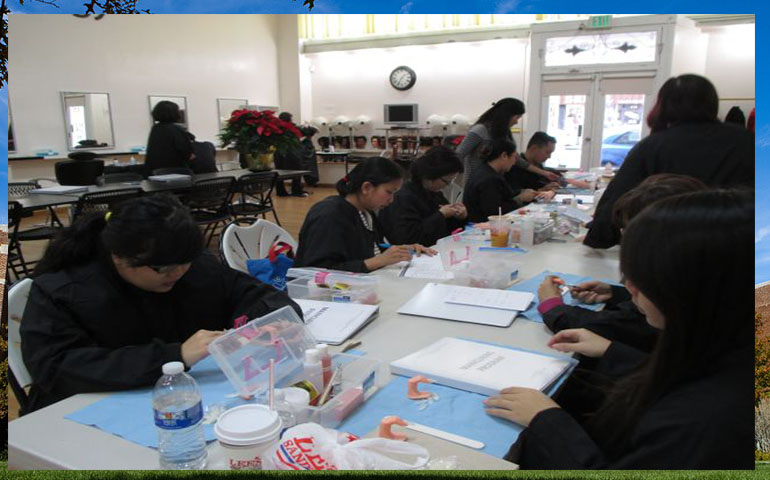
Program of Study
This course is the study of the basic principles of Nail Technology that will prepare students to meet all the requirements necessary to pass state license examination and obtain gainful employment in the field of Nail Technician. Upon successful completion of this course, students are able to demonstrate professional conduct, recognize nail disorders and diseases, and identify and perform procedures for sanitation and nail care services.
Name of Course(s) Within this Program of Study
- Orientation
- Manicuring
- Pedicures
- Electric filing
- Nail tips
- Wraps
- Light gels and acrylic nail
Equipment Used by Instructors and Students.
- Cotton
- Hand Soap.
- Remove previously applied nail polish, using liquid remover and swabs.
- Container and Supplies for Preparation of Wet and Dry Sanitary Maintenance Area.
- Container for Disinfection of Implements.
- Disinfectant Solution that Meets Requirements of Board Regulation.
- Polish Remover.
- Manicure Bowl and Brush.
- Pedicure Tubs
- Emery Boards
- Cuticle Solvent
- Cuticle Oil or Cream
- Hand Lotion
- Liquid Polish (medium to dark shade)
- Cuticle Nippers and Scissors
- Metal Cuticle Pusher
- Plastic/Orangewood Stick
- Sufficient Terry Towels for Manicuring Examination
- Paper Towels
- Portion Cups
- First-Aid Supplies for Cuts
- Sufficient Material and Equipment to Apply Acrylic Nails, Nail Tips, and Nail Wraps
List the skills or competencies to be acquired by the student.
- Clean and sanitize tools and work environment.
- Schedule client appointments and accept payments.
- Remove previously applied nail polish, using liquid remover and swabs.
- Clean customers' nails in soapy water, using swabs, files, and orange sticks.
- Shape and smooth ends of nails, using scissors, files, and emery boards.
- Apply undercoat and clear or colored polish onto nails with brush.
- Advise clients on nail care and use of products and colors.
- Assess the condition of clients' hands, remove dead skin from the hands and massage them.
- Soften nail cuticles with water and oil, push back cuticles, using cuticle knife, and trim cuticles, using scissors or nippers.
- Brush powder and solvent onto nails and paper forms to maintain nail appearance and to extend nails, then remove forms and shape and smooth nail edges using rotary abrasive wheel
Does Training Lead to Licensing or Certification
- Yes
List of Requirements for Eligibility for Licensure:
- Completion of a Board approved course of instruction and achievement of a passing grade on a Cosmetology Board administered exam.
Which Agency certifies or licenses graduates?
- California Board of Barbering and Cosmetology
Is an Externship or Internship Required?
- No
Requirements for Completion
- To complete this program a student must attend a minimum of 85% of the scheduled hours of instruction, achieve an average score of 75% or greater on quizzes and exams, and pass an instructor monitored practical exam demonstrating competence in the fundamentals of the basic manicure care.
Esthetics (Skin Care) 600 hours
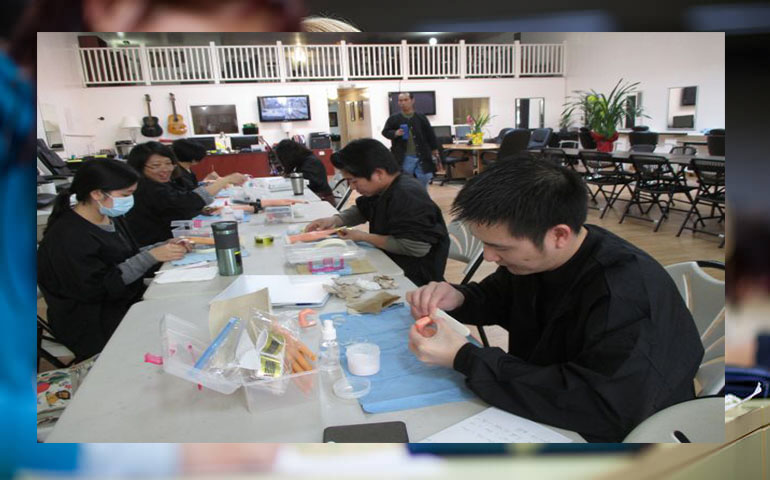
Program of Study
The Esthetics Course offers a complete 600 hour course in the science and art of esthetics. The program is designed to prepare and educate each student in the fundamentals of the basic esthetic education set forth by the California Board of Barbering and Cosmetology. It will also prepare each student for the practical and theory examination for a California Esthetician License. In addition, the course will incorporate the knowledge needed for entry level employment in salons, spas, or clinical esthetics
Name of Course(s) Within this Program of Study
- Skin Care Therapy
- Hair Removal
- Make Up
Equipment Used by Instructors and Students.
- Container and Supplies for Preparation of Wet and Dry Sanitary Maintenance Area
- Hand Soap.
- Container for Disinfection of Implements
- Disinfectant solution
- Terry towels
- Paper towels
- Appropriate draping for all services
- Pencil type makup sharpener
- Cleansing cream
- Massage cream
- Astringent or witch hazel
- Abrasive cleansing scrub
- Waste receptacle (plastic bags)
- Tweezers
- 1 oz portion cups
- Cosmetic applicators
- Cotton balls
- Cotton tipped swabs
- Cleansing tissue
- Powder and liquid foundation
- Eye shadow and eye liner
- Tube mascara and applicator
- Eyebrow Pencils
- Blush
- Lip Color
- Water soluble wax
List the skills or competencies to be acquired by the student.
- Ability to analyze customer’s skin care needs.
- Able to discuss treatments and products with clients.
- Perform facials to cleanse pores and improve skin tone.
- Apply chemical peels to reduce fine lines and age spots.
- Perform simple extractions to remove blackheads.
- Remove unwanted facial hair using depilatory wax.
- Tint eyebrows.
- Instruct customers on skin care and makeup techniques.
- Sterilize equipment and clean work area.
- Massage the face.
- Select and apply cosmetic products such as creams, lotions, and tonics.
Does Training Lead to Licensing or Certification
- Yes
List of Requirements for Eligibility for Licensure:
- Completion of a Board approved course of instruction and achievement of a passing grade on a Cosmetology Board administered exam.
Which Agency certifies or licenses graduates?
- California Board of Barbering and Cosmetology
Is an Externship or Internship Required?
- No
Requirements for Completion
- Students are assigned theory study and a minimum of practical experiences. Theory is evaluated after each unit of study. Practical assignments are evaluated as completed and counted toward course completion only when rated as satisfactory or better. Practical skills are evaluated according to text procedures and performance standards. Students must maintain a theory grade of 75% and pass a final written and practical exam prior to graduation. Students must make up failed or missed tests and incomplete assignments. To complete this program a student must attend a minimum of 85% of the scheduled hours of instruction and pass an instructor monitored practical exam demonstrating competence in the fundamentals of the basic esthetic care.
Barbering 1500 Hours
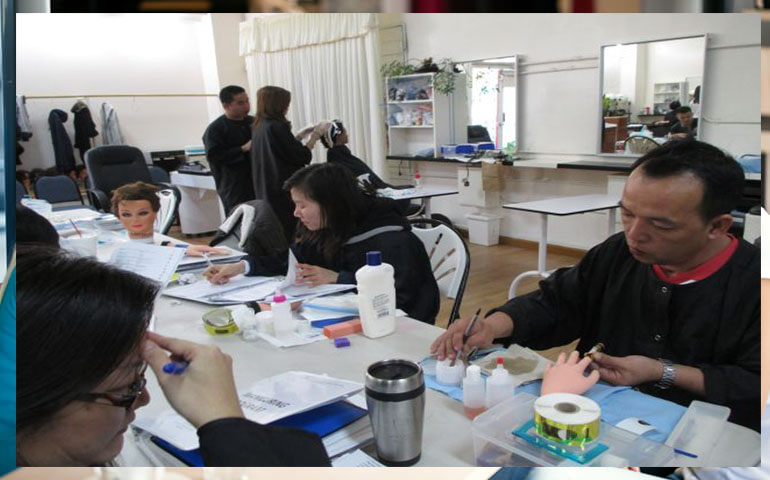
Program of Study
The Barber Program consists of lessons addressing the treatment of hair and scalp. Topics include shampooing, hair cutting, hair styling, shaving, hair coloring, permanent waving and chemical relaxers, facial massage and treatments, sanitation procedures, and salon management. Students successfully completing this program will be eligible to sit for the exam for state licensure in California which is administered the California Board of Barbering and Cosmetology.
Equipment Used by Instructors and Students As required by the Cosmetology Board:
- 1 Time clock
- 3 Shampoo bowls – (when the average daily attendance exceeds 15 students, additional bowls shall be added at the ratio of one for each 5 students in average daily attendance in excess of 15)
- 15 Barber chairs – Chairs shall be spaced at least 4½ feet from center to center (when the average daily attendance exceeds 15 students, additional barber chairs shall be added at the ratio of one for each student in average daily
- Workstations – One workstation for each barber chair. Workstations having a wood surface shall be covered with a hard-based paint or some other nonabsorbent washable material.
- Wet sterilizer – One for each barber chair for individual use of each student. 2 Closed receptacles – For each barber chair, one for disposal of used papers and the other for used linens.
- Classrooms – Equipped with either armchairs suitable for students taking notes, or regular school
- Thermal Hair Straighteners
- 1 Electric curling iron
List the skills or competencies to be acquired by the student.
- Taper
- Side and Back Fade
- High and Tight
- Flat Top
- Buzz
- Military
- Razor Cutting
- Business Professional
- Beard and Mustache Trim
- Other Facial Hair Trim
- Facial Shaving
- Scalp Treatments
- Scalp & Facial Massage
- Shampooing and Hair Care
- Basic Styles
- Networking Skills
- Client Interaction
- Product Support
- Interviewing/Job Placement Skills
- Theory applied to Professional Barbering
Does Training Lead to Licensing or Certification
- Yes
List of Requirements for Eligibility for Licensure:
- Completion of a Board approved course of instruction and achievement of a passing grade on a Cosmetology Board administered exam.
Which Agency certifies or licenses graduates?
- California Board of Barbering and Cosmetology
Is an Externship or Internship Required?
- No
Name of Course(s) Within this Program of Study
- Hairstyling
- Permanent Waving and Chemical Straightening
- Hair Coloring and Bleaching
- Hair Cutting
- Shaving
- Instruction in Health and Safety
- Laws and Regulations
- Health and Safety Considerations
- Disinfection and Sanitation
- Anatomy and Physiology
- Other Board Recommended Studies (communications)
Requirements for Completion
- To complete this program a student must attend a minimum of 85% of the scheduled hours of instruction, achieve an average score of 75% or greater on quizzes and exams, and pass an instructor monitored practical exam demonstrating competence in the fundamentals of the basic manicure care.
Cosmetology 1600 Hours
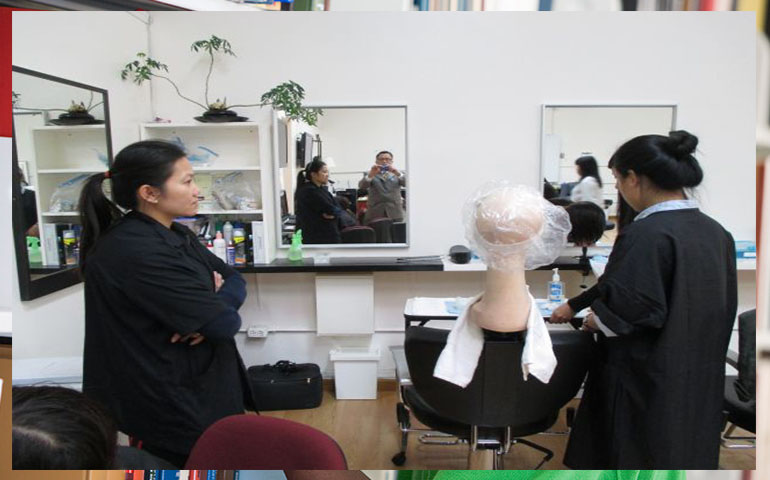
Program of Study
A 1600-hour course which includes the study and practice of all aspects of the beautification and care of the hair, skin and nails. The course provides for both classroom instruction and supervised practice of job related skills such as hairdressing, hair cutting, coloring, manicuring and skin care services. The program also includes the study of relative subjects such as, bacteriology, anatomy, chemistry, health, etc.
Name of Course(s) Within this Program of Study
- 1 Hair Care
- 2 Facial
- 3 Nail Care
- 4 Make Up
Equipment Used by Instructors and Students.
- Sufficient electrical equipment and dermal lights for giving instruction in skin care and electrical facials ( at least one red, blue and white light).
- mannequins, with full head of hair
- Time clock
- Shampoo bowls
- Dryers
- facial chairs or facial couches
- manicure stations
- electrical cap
- electric comb
- non electric curling irons
- stove
- extbook approved by the board
- Performance Criteria
THERMAL HAIR STRAIGHTENERS
TEXT AND REFERENCE BOOKS
List the skills or competencies to be acquired by the student.
- Wet Hair Styling
- Thermal Hair Styling.
- Permanent Waving
- Chemical Straightening
- Hair cutting.
- Hair coloring
- Bleaching
- Facials Manual
- Electric
- Make-up
- Manicuring and Pedicuring
- Liquid and Powder Brush-on
- Artificial Nail Tips
- Nail Wraps and Repairs
Does Training Lead to Licensing or Certification
- Yes
List of Requirements for Eligibility for Licensure:
- Completion of a Board approved course of instruction and achievement of a passing grade on a Cosmetology Board administered exam.
Which Agency certifies or licenses graduates?
- California Board of Barbering and Cosmetology
Is an Externship or Internship Required?
- No
Requirements for Completion
Students shall complete the minimum required number of theory hours and practical operations as specified by the State of California, with a final evaluation score for practical and written test of 75% or better. In addition to the state’s requirements, students at must also complete the following course work: To complete this program a student must attend a minimum of 85% of the scheduled hours of instruction, and pass an instructor monitored practical exam demonstrating competence in the practice of all aspects of the beautification and care of the hair, skin and nails.
1. Complete all assignments from the standard theory and practical workbooks.
2. View videos from required viewing video list.
3. Prepare a photo portfolio of your finished work. (Minimum of 15 photos.)
4. Prepare an organized notebook with subject headings and procedure sheets.
5. Complete a typed functional resume and cover letter (class given for creating a resume.) Upon satisfactory completion of 1600 hours, the State requirements, and the Course Work listed above, the student shall receive Katie Skills Center’s certified diploma.
Barber Crossover 400 Hours
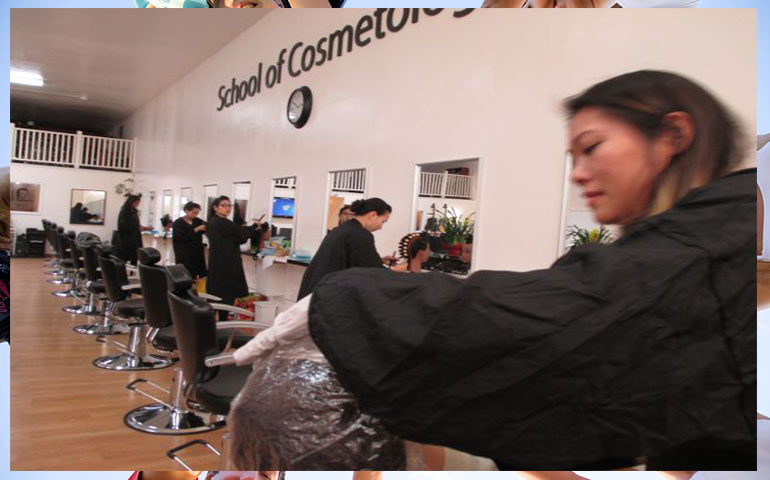
NOW ENROLLING
Cosmetology Crossover 400_Hours
NOW ENROLLING
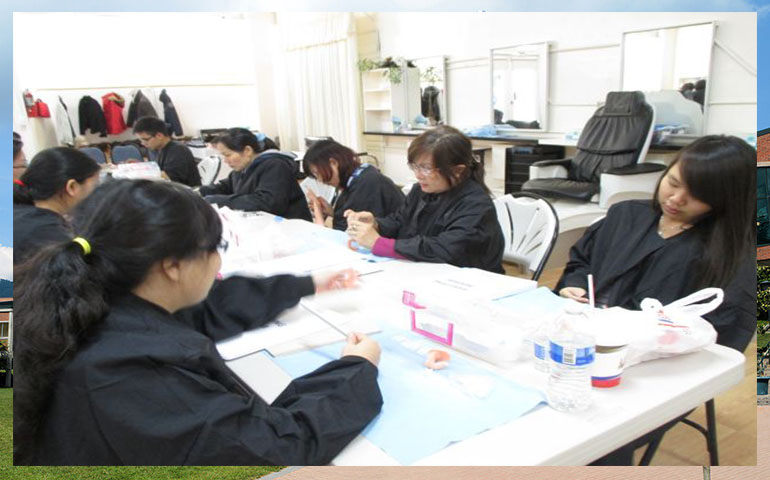
Katie Skills Center
Massage Therapy 600 Hours
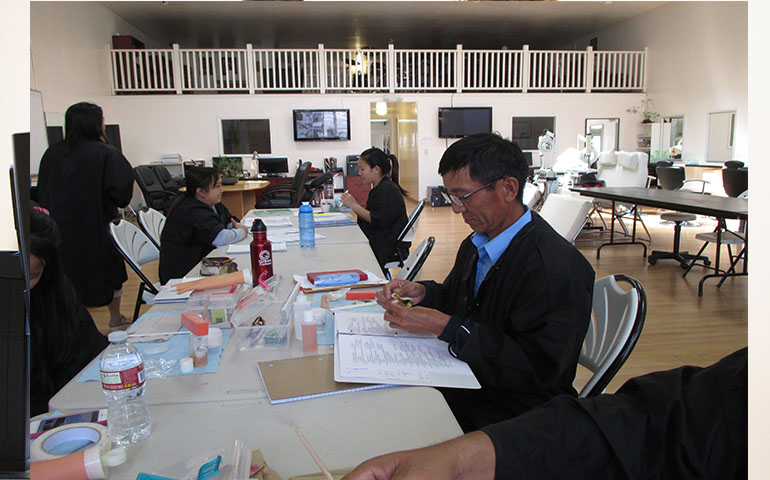
Program of Study
This program is designed to provide students with complete and comprehensive training in all areas of massage. Specific emphasis is placed on preparing students with knowledge to open their own massage clinic or to become employed in the massage field working in a doctor’s office, a chiropractor’s office, an acupuncturist’s office or a health center. This program builds upon our 600 hours program providing greater emphasis on the best business practices for Message Therapists, the importance and practice of professional ethics, the effective management of a successful massage clinic and the art of successful communication.
Name of Course(s) Within this Program of Study : CAMTC REQUIRED
- Anatomy
- Physiology
- Contraindications
- Heath & Hygiene
- Business & Ethics
- Medical Terminology
- Deep Tissue Massage
- Sports Massage
- Pregnancy Massage
- Massage Therapies and Healthcare
Name of Course(s) Within this Program of Study : Primary Content
- Professionalism
- Nutrition
- Massage and the Legal Environment
- Clinical Environment
- Foundational Clinical Skills
- Development of Clinical Skills
- Refinement of Clinical Skills
- Massage Techniques for Special Populations
- Rehabilitative Massage I
- Rehabilitative Massage II
- Relaxation Massage
Name of Course(s) Within this Program of Study : Business Development
- Business Management
- Professional Development
- Theories of Holistic Wellness
- Client Relations and Communications
- Business Skills
- Allied Modalities
- Assessment Skills
- Special Populations
- Oriental Theory
Equipment Used by Instructors and Students.
- Anatomical charts
- Essential oils
- Body wrap materials.
- Massage chairs.
- Massage stools
- Portable massage tables
- Treatment tables
- Heat lamps
- Cold packs
- Hot packs
- Massage stone sets
List the skills or competencies to be acquired by the student.
- Confer with clients about their medical histories and problems with stress or pain to determine how massage will be most helpful.
- Apply finger and hand pressure to specific points of the body
- Massage and knead muscles and soft tissues of the body to provide treatment for medical conditions, injuries, or wellness maintenance.
- Maintain treatment records
- Provide clients with guidance and information about techniques for postural improvement and stretching, strengthening, relaxation, and rehabilitative exercises.
- Assess clients' soft tissue condition, joint quality and function, muscle strength, and range of motion.
- Develop and propose client treatment plans that specify which types of massage are to be used.
- Refer clients to other types of therapists when necessary.
- Use complementary aids, such as infrared lamps, wet compresses, ice, and whirlpool baths to promote clients' recovery, relaxation, and well-being.
- Speaking — Talking to others to convey information effectively.
- Active Listening — Giving full attention to what other people are saying, taking time to understand the points being made, asking questions as appropriate, and not interrupting at inappropriate times.
- Critical Thinking — Using logic and reasoning to identify the strengths and weaknesses of alternative solutions, conclusions or approaches to problems.
- Service Orientation — Actively looking for ways to help people.
- Social Perceptiveness — Being aware of others' reactions and understanding why they react as they do.
- Judgment and Decision Making — Considering the relative costs and benefits of potential actions to choose the most appropriate one.
- Reading Comprehension — Understanding written sentences and paragraphs in work related documents.
Students will be instructed in the art of active communication and the importance of a client centered business communication. These topics will include:
Does Training Lead to Licensing or Certification
- Yes
Which Agency certifies or licenses graduates?
- Oakland Police Dept or CAMTC
Certification Requirements:
- Massage training can lead to certification by CAMTC, the California Massage Therapy Council. However, certification is voluntary. Local laws exist pertaining to work as a massage therapist or other body worker commonly called a masseuse or a massage practitioner. If an individual chooses not to be certified by CAMTC, the individual may opt to register in the community in which one chooses to work by contacting the licensing division or the city managers office for information pertaining to a given city’s jurisdiction.
- This institution exercises its autonomy and chooses to offer programs 600 and 1000 hours in length. The school ownership is of the opinion that the development of professional skill requires more that 250 or 500 hours of study.
- CAMTC certification is granted to those individuals who successfully complete a 500 hour program of instruction, pass a background check and meet other requirements of CAMTC.
Requirements for Completion
- To complete this program a student must attend a minimum of 85% of the scheduled hours of instruction, achieve an average score of 75% or greater on quizzes and exams, and pass an instructor monitored practical exam demonstrating competence in the fundamentals of the basic manicure care.
Massage Therapy 1000 Hours

Program of Study
This program is designed to provide students with complete and comprehensive training in all areas of massage. Specific emphasis is placed on preparing students with knowledge to open their own massage clinic or to become employed in the massage field working in a doctor’s office, a chiropractor’s office, an acupuncturist’s office or a health center. This program builds upon our 1000 hour program providing greater emphasis on the best business practices for Message Therapists, the importance and practice of professional ethics, the effective management of a successful massage clinic and the art of successful communication.
Name of Course(s) Within this Program of Study : CAMTC REQUIRED
- Anatomy
- Physiology
- Contraindications
- Heath & Hygiene
- Business & Ethics
- Medical Terminology
- Deep Tissue Massage
- Sports Massage
- Pregnancy Massage
- Massage Therapies and Healthcare
Name of Course(s) Within this Program of Study : Primary Content
- Professionalism
- Nutrition
- Massage and the Legal Environment
- Clinical Environment
- Foundational Clinical Skills
- Development of Clinical Skills
- Refinement of Clinical Skills
- Massage Techniques for Special Populations
- Rehabilitative Massage I
- Rehabilitative Massage II
- Relaxation Massage
Name of Course(s) Within this Program of Study : Business Development
- Business Management
- Professional Development
- Theories of Holistic Wellness
- Client Relations and Communications
- Business Skills
- Allied Modalities
- Assessment Skills
- Special Populations
- Oriental Theory
Equipment Used by Instructors and Students.
- Anatomical charts
- Essential oils
- Body wrap materials.
- Massage chairs.
- Massage stools
- Portable massage tables
- Treatment tables
- Heat lamps
- Cold packs
- Hot packs
- Massage stone sets
List the skills or competencies to be acquired by the student.
- Confer with clients about their medical histories and problems with stress or pain to determine how massage will be most helpful.
- Apply finger and hand pressure to specific points of the body
- Massage and knead muscles and soft tissues of the body to provide treatment for medical conditions, injuries, or wellness maintenance.
- Maintain treatment records
- Provide clients with guidance and information about techniques for postural improvement and stretching, strengthening, relaxation, and rehabilitative exercises.
- Assess clients' soft tissue condition, joint quality and function, muscle strength, and range of motion.
- Develop and propose client treatment plans that specify which types of massage are to be used.
- Refer clients to other types of therapists when necessary.
- Use complementary aids, such as infrared lamps, wet compresses, ice, and whirlpool baths to promote clients' recovery, relaxation, and well-being.
- Speaking — Talking to others to convey information effectively.
- Active Listening — Giving full attention to what other people are saying, taking time to understand the points being made, asking questions as appropriate, and not interrupting at inappropriate times.
- Critical Thinking — Using logic and reasoning to identify the strengths and weaknesses of alternative solutions, conclusions or approaches to problems.
- Service Orientation — Actively looking for ways to help people.
- Social Perceptiveness — Being aware of others' reactions and understanding why they react as they do.
- Judgment and Decision Making — Considering the relative costs and benefits of potential actions to choose the most appropriate one.
- Reading Comprehension — Understanding written sentences and paragraphs in work related documents.
Students will be instructed in the art of active communication and the importance of a client centered business communication. These topics will include:
Does Training Lead to Licensing or Certification
- Yes
Which Agency certifies or licenses graduates?
- Oakland Police Dept or CAMTC
Certification Requirements:
- Massage training can lead to certification by CAMTC, the California Massage Therapy Council. However, certification is voluntary. Local laws exist pertaining to work as a massage therapist or other body worker commonly called a masseuse or a massage practitioner. If an individual chooses not to be certified by CAMTC, the individual may opt to register in the community in which one chooses to work by contacting the licensing division or the city managers office for information pertaining to a given city’s jurisdiction.
- This institution exercises its autonomy and chooses to offer programs 600 and 1000 hours in length. The school ownership is of the opinion that the development of professional skill requires more that 250 or 500 hours of study.
- CAMTC certification is granted to those individuals who successfully complete a 500 hour program of instruction, pass a background check and meet other requirements of CAMTC.
Requirements for Completion
- To complete this program a student must attend a minimum of 85% of the scheduled hours of instruction, achieve an average score of 75% or greater on quizzes and exams, and pass an instructor monitored practical exam demonstrating competence in the fundamentals of the basic manicure care.

